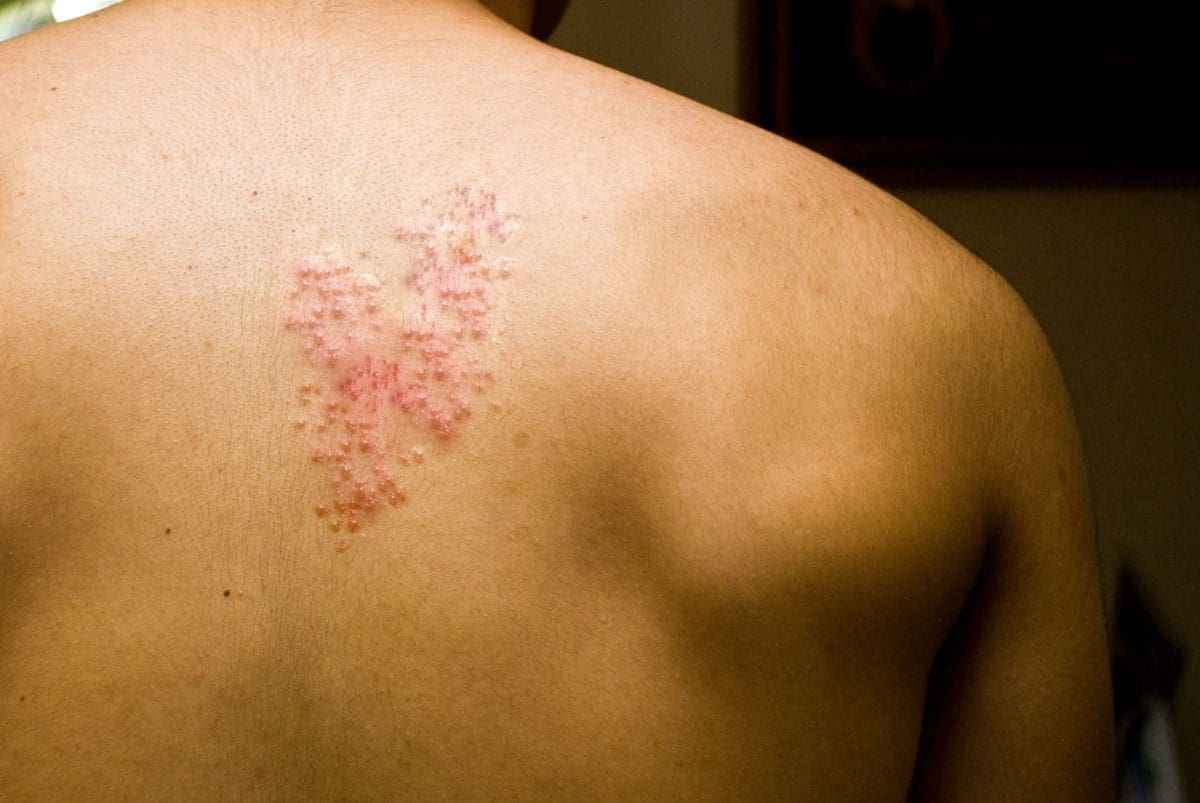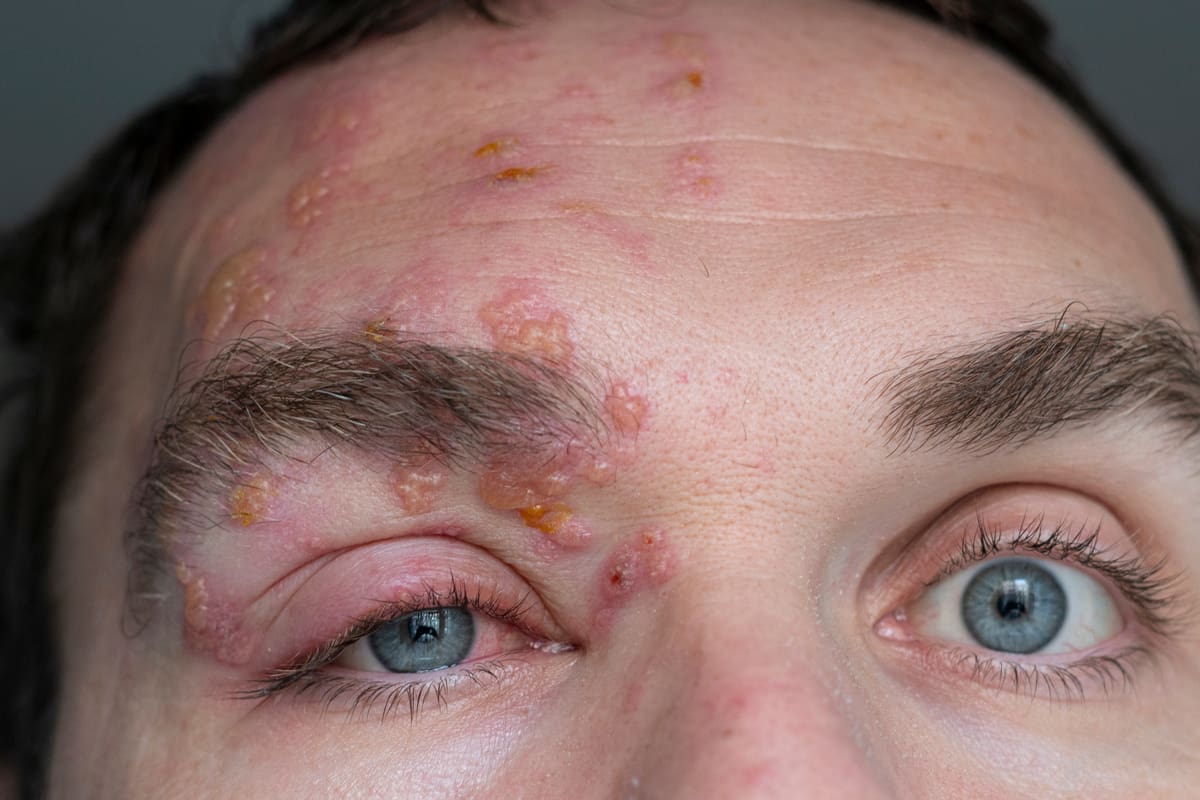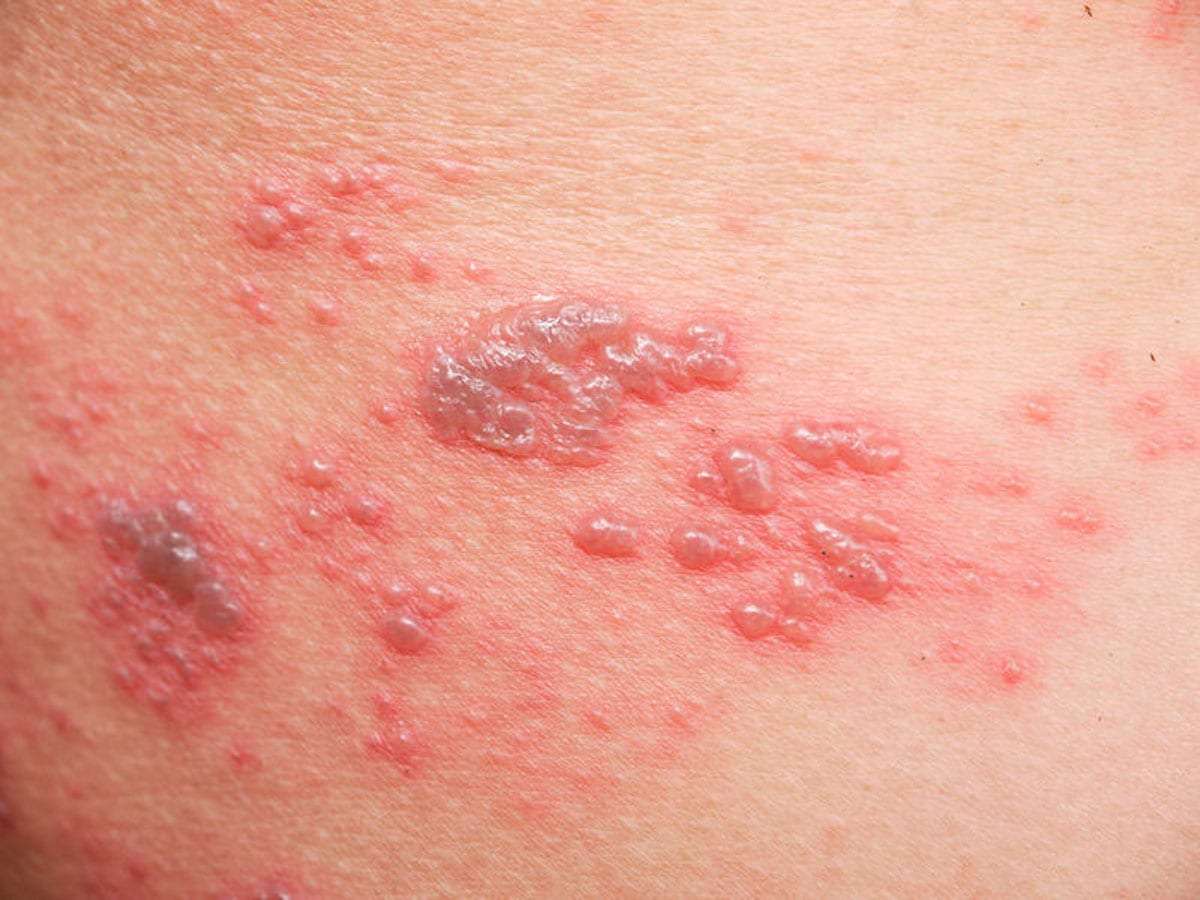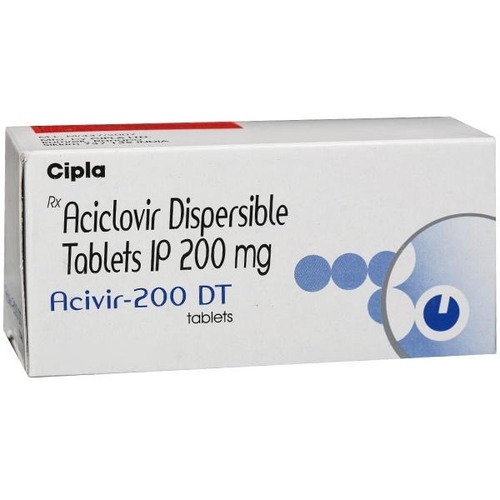
Acyclovir is an antiviral medication widely used to treat viral infections, including genital herpes, herpes zoster (shingles), and varicella (chickenpox). Acyclovir comes in the form of an oral tablet, capsule, buccal tablet, and oral suspension that needs to be taken by mouth. Acyclovir is also available in the form of cream and ointment that is used externally on the skin. Additionally, Acyclovir is also available in an Intravenous drug form that is administered by a healthcare professional only.
All You Need To Know About Shingles (Herpes Zoster)?
Shingle is a viral infection causing an outbreak of a painful rash. The condition is caused by the varicella-zoster virus, which also causes chickenpox. Chickenpox is itchy blisters that may start on the back, chest, and face and then spread to the entire body. Shingles appear as a rash followed by shooting pain. It occurs on one side of the body, mainly in a particular area.
A shingles rash appears as a bunch of small bumps which look different than the surrounding skin and occurs differently on various skin tones. On lighter skin, these bumps appear red-colored, while on darker skin, these bumps appear pink, purple, brown, or greyish.

The bumps then turn into fluid-filled blisters, which also differ in presentation. The blisters can be brown, red, purple, or brown, depending on the skin tone of the sufferer. Usually, these blisters dry out and crust over within 7 to 10 days.
There are treatments available for shingles that can ease symptoms and relieve pain; however, there is no cure for shingles. There are also vaccines available against shingles.
Why Do Shingles Occur?
When you suffer from chickenpox in childhood, your body combats the varicella-zoster virus that causes chicken pox. The physical symptoms of chickenpox go away after some days, but the virus stays inside your body.
In adulthood, the virus may become active again after a certain amount of time. When the varicella-zoster virus becomes active years after you heal from chicken pox, the reappearance of the virus comes in the form of shingles. Once the varicella-zoster infects your body, it first causes chicken pox, and later it appears as shingles.
Chickenpox is usually considered a childhood disease; however, it may happen in adults too. After chickenpox, the virus moves into the nerve tissues around your brain and spinal cord, and it stays here. When it activates again after some years, it travels along the nerve fibers to the skin and lands its second punch called shingles rash.
Are Shingles Common?
Every year around 1 million people are diagnosed with shingles in the US. The chances of getting shingles increases as you age and get older, with about half the diagnoses happening in people over 50 years of age. About 10% of people who have chickenpox in their lives develop shingles in older age.
The varicella-zoster virus doesn’t leave the body after causing chickenpox; instead, it stays in the spinal nerve root known as the dorsal root ganglion. In most cases, the virus stays here quietly without causing any problems.
Who Is At Risk Of Developing Shingles?
People who have had chickenpox earlier who are at risk of developing shingles include people above the age of 50 years, who are suffering from stress, experienced trauma, have been ill, and people with a weakened immune system such as people with HIV, cancer, receiving chemotherapy or organ transplant recipients.
Researchers are not sure that the virus reactivates, but it typically happens during stress. A weakened immune system is more likely to wake up the varicella-zoster virus. People (kids and adults) who are not vaccinated against chickenpox and eligible people who do not get shingles vaccines are also more likely to get shingles.
Can Shingles Happen More Than Once?
Yes, people may get shingles infection more than once. Shingles can happen only once, which is among the biggest myths about shingles infection. Unfortunately, it’s not true. You may develop more than one episode of infection. However, if you get shingles, you usually do not get the rash at the same place you had it earlier.
Symptoms Of Shingles Infection
Early symptoms of a shingles rash may include fever, chills, headache, tiredness, upset stomach, and sensitivity to light. Other symptoms that are followed by the initial symptoms and appear after a few days of developing the infection are:
- An itching, burning, and tingling sensation around the infected area.
- Redness in the affected area.
- A raised rash in a particular small area of skin.
- Fluid-filled blisters that break and scab over.
- Mild to severe pain in the affected skin.
Usually, pain is the first sign of shingles. Pain can be intense in some cases. Depending on the painful area, sometimes the infection be mistaken for lungs, kidneys,s or heart problems. Some people experience pain due to shingles even without developing a rash.
Mostly, shingles rash occurs as a stripe of blisters that hush up around the left or right side of the torso. Sometimes the shingles rash may also occur around the eye or on one side of the face or neck.
When Is The Time To See A Doctor
Contact your doctor or healthcare provider immediately if you notice shingles symptoms, particularly in the following situations:
- A rash and pain near any eye as the infection may lead to permanent eye damage if left untreated
- If you are above 50 years of age because age increases the chances of complications
- If you or someone in your family has a weakened immune system due to chronic illness, cancer, or certain medications.
- If the rash is excruciating and widespread.
How Long Does The Shingles Outbreak Last?

It may take 3 to 5 weeks after you begin to experience the symptoms until the rash disappears entirely. You may feel pain in a certain area of your skin a few days before you develop the rash. The pain appears as burning, itching, shooting, or stabbing, and it usually occurs before the rash appears.
Then a raised rash develops as a patch or band on one side of the body. Not always, but usually, the rash appears around the waistline or any one side of your face, neck, or trunk area. It can also develop in other body parts, such as arms or legs.
Within 3 to 4 days, the rash converts into red-colored and fluid-filled open blisters. Mostly, these blisters start to dry out and crust over within ten days. The scabs may take 2 to 3 weeks to clear up completely.
Do Shingles Always Appear As A Rash?
Some people may not get a rash during a shingles infection. If you do not have a rash but other signs of shingles, talk to your doctor as soon as possible to get effective treatment for early shingles. Even if you do not have shingles but similar kinds of symptoms without a rash, contact your healthcare provider to get it diagnosed correctly and to get proper treatment.
Why Do Shingles Mostly Appear On One Side Of The Body?
In most cases, shingles appear on any one side of the body, such as the face and torso are common areas. The shingles rash remains somewhat confined to an area, and it does not spread over the e tire body. It happens because the virus travels in particular nerves, so often, shingles occur like a band on one side of the body. This band parallels the area where nerves convey signals.
Is Shingles Infection Transmittable?
People with shingles infection can not spread shingles to another person; however, they can definitely spread chickenpox. Varicella zoster virus, which causes chicken pox and shingles, is spread through skin-to-skin contact with the fluid that discharges from the blisters.
Shingles are hardly spread through breathing as airborne viruses. If you have shingles and your rash is in the blister phase, make sure you stay away from people who have not had chickenpox or who have not got the chickenpox vaccine. Also, keep your shingles rash covered to avoid spreading it to others.
People with shingles are contagious until the rash is completely dried and crusted over. The varicella virus can only cause chickenpox in people who never had chickenpox and who have not been vaccinated against chickenpox.
Shingles Diagnosis
Shingles are diagnosed depending on the way the rash is dispersed on the skin. The shingle rash blisters usually develop in a band on any one side of the body. Shingles can also be diagnosed in the laboratory using rasps or a swab of the blister’s fluid.
Complications Associated With Shingles

You may continue to experience nerve pain in the affected area even after the shingles rash completely disappears. Over 10% of people who develop shingles also develop postherpetic neuralgia. Postherpetic neuralgia may last for months or even years and become severe.
Researchers could not find why only some people develop postherpetic neuralgia, and some do not. It may be because nerves become more sensitive or because the virus invades and damages the central nervous system.
Other complications associated with shingles include nerve issues such as itching or numbness, a bacterial infection of the shingles rash, and ear and eye inflammation if the rash appears near these body organs.
Treatment For Shingles
Shingles are not a life-threatening condition. Although there is no cure available for shingles, there are some treatment options available to manage the symptoms. It can be extremely painful for some people. Vaccines can help reduce the risk of getting shingles. Early treatment can shorten a shingle infection and also decrease the chances of complications such as postherpetic neuralgia.
Antiviral Medications
Antiviral medications such as Acyclovir (Zovirax), oral Valacyclovir (Valtrex), and Famciclovir (Famvir) can ease the symptoms and discomfort sooner. These are prescription drugs available on a doctor’s prescription only. For maximum and better benefits you should start with the antiviral medications within 72 hours of the rash onset. These medications can also help avert the pain that may happen months and years after the rash heals.
Over-the-counter-medications
These drugs include Ibuprofen and Acetaminophen and can effectively relieve pain.
Acyclovir Treatment For Herpes Infections

Acyclovir works by reducing the ability of the virus to replicate in your body. It does not cure herpes infections; however, it effectively treats the symptoms and provides significant relief. Even after taking Acyclovir, the virus stays alive inside your body, and it can get active again in the future.
Acute Herpes Zoster Treatment
A meta-analysis of 5 randomized controlled trials was considered the time of complete pain resolution of acute herpes zoster. During the acute treatment when Acyclovir treatment with 800 mg five times a day for seven days was started within 48 hours of initial symptoms, the complete pain resolution was noticed sooner than with the placebo treatment. The results were the same when the Acyclovir therapy was started between 48 to 72 hours after the first symptoms. The acute pain resolution occurred within 14 days of the Acyclovir treatment regimen.
Herpes Zoster Treatment With Oral Acyclovir
Double-blind, placebo-controlled trials of Acyclovir 400 mg and 800 mg have been performed to study oral Acyclovir therapy for herpes zoster. The two dosages were given five times daily for ten days.
In comparison to placebo recipients, patients who received Acyclovir high-dosage experienced an appreciably reduced period of viral shedding, appreciably quicker time to 50% scabbing, considerably enhanced time to 50% healing, and just after two days of treatment, significantly reduced frequent development of new lesions.
The severity and duration of acute pain were significantly less in patients who got Acyclovir, with variations in the severity of pain achieving statical significance between 3 to 10 days and relating with the treatment variations in new lesion development. In the studies of Acyclovir, 400 mg five times daily dosing schedule, the differences between placebo and Acyclovir recipients were not considerable.
In higher dosage studies, after the six-month follow-up, Acyclovir recipients noticed reduced post-zoster pain as compared to placebo recipients. The differences in the occurrence of pain were most considerable for the presence of tenacious [aijn in the initial three months of the follow-up.
Oral Acyclovir dosages appear to be effective and free of adverse reactions. The conclusion of the study is oral Acyclovir 800 mg five times daily for ten days is a better treatment for acute herpes zoster infection in comparison to oral Acyclovir 400 mg five times daily, and it suitably transforms the course of the infection.
Acyclovir Dosage For Genital Herpes, Shingles, And Chicken Pox

Herpes infections are caused by herpes simplex virus and these can be extremely uncomfortable for sufferers. There is no cure for these infections but Acyclovir and other antiviral medications can help with the symptoms. The infected person can spread genital herpes and herpes zoster virus to another person which is why it is important to take proper treatment and avoid sexual contact to avoid spreading the infection to others.
Acyclovir is a common medication used to treat viral infections caused by herpes simplex viruses such as genital herpes, shingles, cold sores, and chicken pox. It can be used as a combination therapy with other medications. Acyclovir can be taken with or without food as prescribed by your healthcare provider.
For the first episode of genital herpes, the dosage is Acyclovir 200 mg orally five times daily for 10 days. For severe disease or in case of complications that need hospitalization 5 mg/kg intravenously is administered every eight hours for five days.
Typically oral Acyclovir dosage for adults to treat genital herpes is Acyclovir 200 mg 5 times daily (every 4 hours) for 7 to 10 days or 400 mg three times a day for 5 to 10 days. For herpes zoster, Acyclovir 800 mg is prescribed five times a day (every 4 hours) for 7 to 10 days. For treating chickenpox, Acyclovir 800 mg is prescribed to take four times a day.
Intravenous Acyclovir dosage (mg kg)
The typical adult intravenous dose of Acyclovir is 5 to 10 mg/kg every 8 hours for 7 to 10 days.
Acyclovir Dosage for Shingles (herpes zoster)
The usual adult (18-64 years) dosage:
800 mg 5 times a day for ten days. Make sure to maintain 4 hours gap between each dose.
Immunocompromised patients: 10 mg/kg Intravenous every 8 hours for seven days.
Treatment should be started as soon as you notice the earliest sign of the herpes zoster, and parenteral dosing depends on the ideal body weight.
Oral Acyclovir treatment is considered an alternative treatment for treating acute localized dermatomal herpes zoster in HIV-infected adult patients. Intravenous Acyclovir is a favored treatment with excessive cutaneous lesions or visceral involvement.
Typical adult dosage for herpes zoster prophylaxis:
For HIV-infected adults (post-exposure prophylaxis), the dosage is 800 mg given orally five times daily for five to seven days. It begins seven to ten days after the exposure.
Varicella-zoster immune globulin is the ideal treatment for post-exposure prophylaxis, and oral antiviral treatment is used in case passive immunization is not possible. When antiviral therapy is considered, varicella vaccines should be avoided for at least 72 hours after the last dose of antivirals.
Typical pediatric dose for herpes zoster
Immunocompetent host (parenteral): Dosage for less than one year is 10 mg/kg intravenous every 8 hours for seven to 10 days, and for one year and older, 500 mg/m2 intravenous every 8 hours for seven to ten days. For 12 years and older, the oral dosage is 800 mg five times daily for five to seven days. For immunocompromised hosts, the dosage is 10 mg/kg intravenous every 8 hours for seven to ten days.
HIV-exposed and HIV-infected children: The dosage for uncomplicated zoster is 20 mg/kg orally four times daily for seven to ten days, and the maximum dosage is 800 mg.
For severe immunosuppression (CDC immunologic category 3), trigeminal or sacral nerve involvement, and extensive multidermayomal or disseminated zoster, the dosage is 10 mg/kg intravenous every 8 hours until cutaneous lesions and visceral disease are completely resolved. Then your doctor may switch to oral treatment that includes a ten to fourteen-day course of treatment.
Typical pediatric dose for herpes zoster prophylaxis
HIV-infected children and adolescents: The dosage for post-exposure prophylaxis in HIV-infected children and adolescents is 20 mg/kg orally four times daily for seven days starting seven to ten days after the exposure.
Take As Prescribed
Acyclovir oral treatment is prescribed as a short-term treatment for shingles, genital herpes, and chicken pox. It is prescribed as a long-term treatment for recurring genital herpes infections. Acyclovir may cause serious risks and undesired effects when not taken as prescribed by a healthcare professional.
Do not stop taking Acyclovir tablets suddenly or without talking to your doctor, as the symptoms may not get better or may get worse. Even if you are feeling better after a few doses, you should complete the course of treatment to clear up the infection completely.
If you usually miss doses or do not take the medication as per the recommended dose, your medication will not work as expected. In case you are taking Acyclovir to vert flare-ups of infection, a certain amount of the drug should be inside your body all the time. Do not stop taking Acyclovir without consulting your healthcare provider.
Missed dose
In case you missed a dose, take it as soon as you realize it. If you remember about the missed dose a few hours before your next dose as per schedule, skip the missed dose and continue with the next dose. Do not take two doses at the same time to make up for the missed dose, as it may cause serious side effects.
Overdose
If you take too much of Acyclovir accidentally, you can have dangerous levels of the medication in your body and experience severe side effects. If you have consumed too much of the drug, call your doctor immediately or contact a local poison control center. In case of severe symptoms of a drug overdose, call the nearest emergency room for immediate help.
Things To Keep In Mind While Taking Acyclovir

Take it exactly as suggested by your doctor or healthcare professional. You can take Acyclovir tablets with or without food as prescribed. Taking Acyclovir with food can help avoid an upset stomach for some people. Do not crush or cut the tablet and follow the dosing interval carefully.
Patients should get their renal function accessed prior to Acyclovir therapy. Patients should drink plenty of water and liquids to maintain adequate hydration while taking this drug. Also, patients should always keep in mind that Acyclovir is not a complete cure for shingles or other herpes infections so they need to take proper precautions as suggested by the health care provider.
Acyclovir Warnings
Like any other medication, Acyclovir also comes with some warnings that you should know about.
Allergy warnings
Acyclovir may cause a severe allergic reaction in certain people who are allergic to Acyclovir or other ingredients in this drug. Symptoms of an allergic reaction include rash, trouble breathing, hives, and swelling in the throat or tongue. Don’t take this drug if you are allergic to Acyclovir or if you ever had an allergic reaction to this drug.
People with kidney problems
People with existing or a history of kidney problems may not be able to eliminate Acyclovir from their bodies well. It can increase the levels of medication in the body and increase the risk of side effects.
Taking this drug inappropriately may decrease kidney function, which means your existing kidney conditions may become worse. Your healthcare provider will adjust your dosing schedule depending on the condition of your kidneys and how well your kidneys can tolerate the drug.
Pregnant women
Acyclovir is a B-category pregnancy medication. Studies of Acyclovir in pregnant animals have not demonstrated any risk to the fetus or birth defects. Not enough studies were performed on pregnant women to evaluate if this drug is safe or not for the fetus.
Make sure you talk to your doctor if you are pregnant or trying to conceive. This drug is only prescribed to pregnant women if the advantages justify the probable risk to the fetus. Also, talk to your doctor immediately if you conceive while you are taking this medication.
Breastfeeding women
Acyclovir can pass into the breast milk and may impact the nursing infant. If you are breastfeeding your baby, tell your doctor. Your doctor may ask you to stop taking this medication or stop breastfeeding.
Elderly people
The kidneys of older adults may not work as well as they are expected to, and it can cause their boy to process medications more slowly. It may make more levels of the drug stay in their bodies longer. It increases the potential risk of side effects. Elderly patients are at more risk to experience reduced renal function and may require dose reduction to avoid that.
Children
Acyclovir has not been studied in pediatric patients younger than two years of age. The efficacy and safety of oral formulations have not been established in children below two years.
Acyclovir Side Effects
Common side effects of this drug include nausea, vomiting, diarrhea, headache, and weakness. These are mild side effects that do not require any treatment and go away within a few days.
Serious side effects of Acyclovir include unusual changes in mood, confusion, trouble speaking, shaky movements, hallucinations, seizures, coma, fatigue, liver problems, muscle pain, rash, hives, breaking of skin, vision changes, and kidney failure. If you experience severe side effects or your side effects do not get better within a few days, call your doctor as soon as possible and seek medical help.
